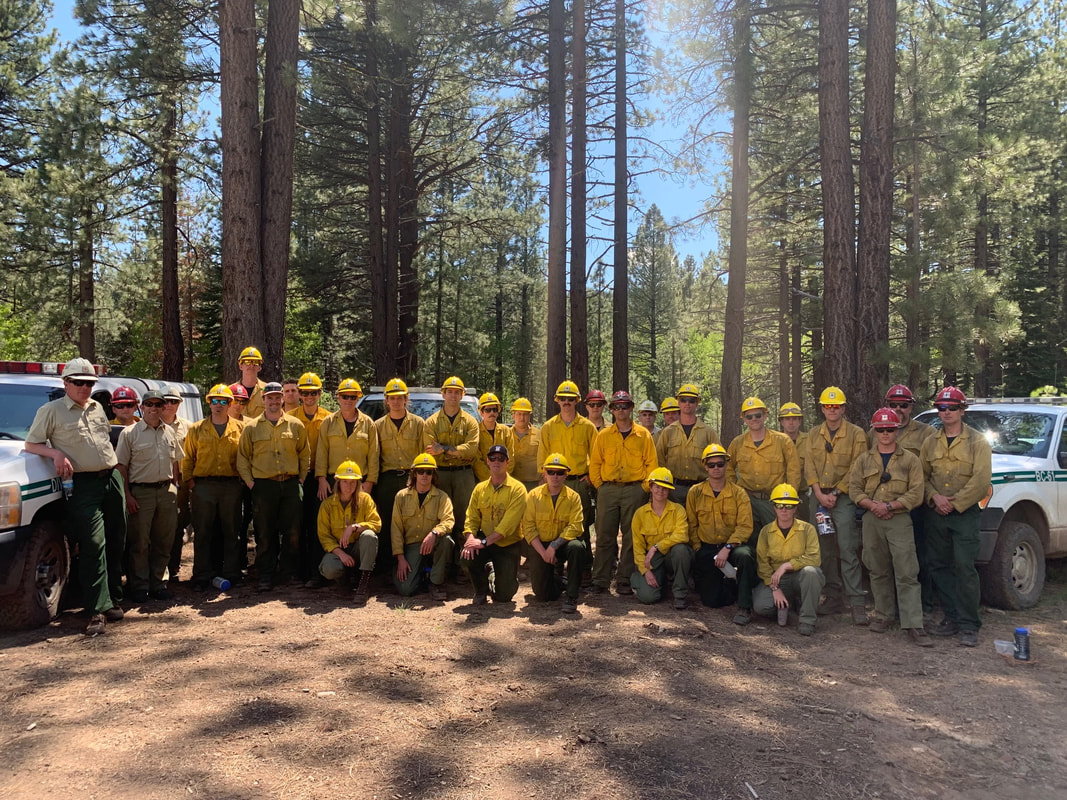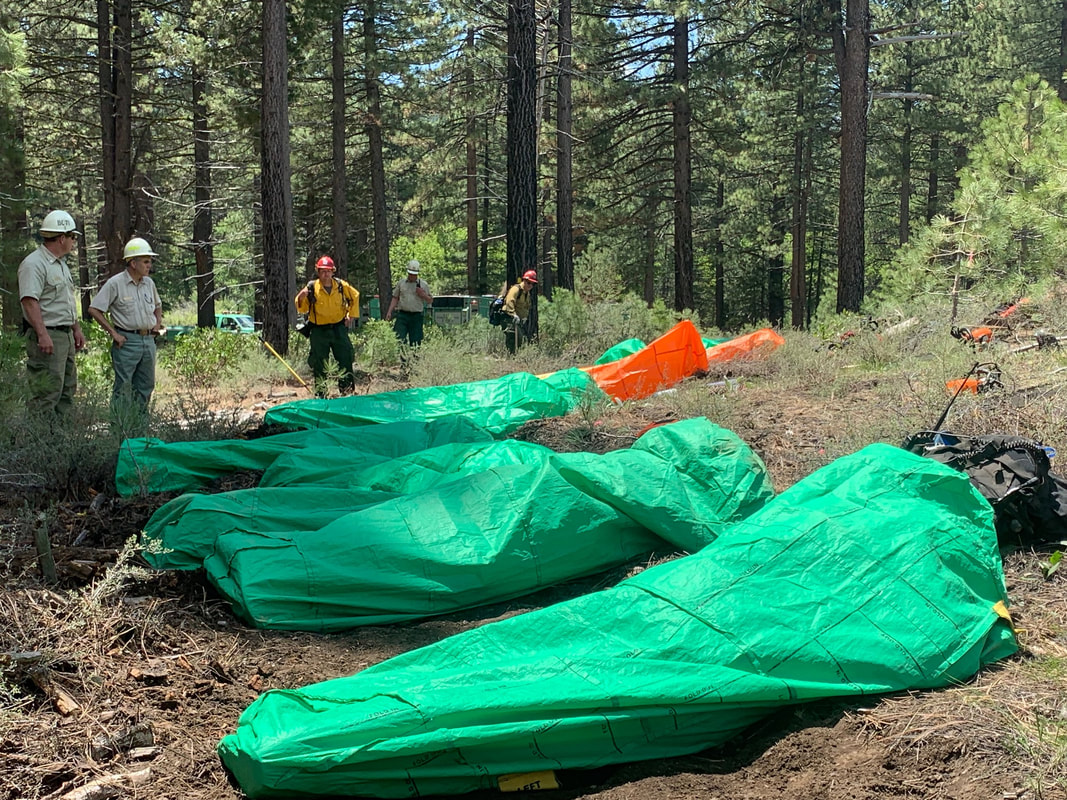U.S. Forest Service
July 2019
Meredith Anello, [email protected], (530) 587-3558
Sierraville, Calif. – “Sierraville Ranger District, vegetation fire, area of Cottonwood Campground for Engine 61, Engine 62, Engine 73, Engine 371, Engine 72, and for Battalion 61 notification. Standby for checkback.” As soon as this dispatch was heard, Tahoe National Forest Truckee and Sierraville Ranger District engine crews responded to this simulated wildfire for the annual East Zone Fire Readiness Proficiency Drill.
On the Tahoe National Forest, fire managers and resources are prepared year-round to respond to natural and human-caused wildfire, as well as other all-hazard incidents that occur every year in the Tahoe National Forest and nationally. When the seasonal firefighters, some starting as rookies like Jake Ward on Engine 73, report to duty mid-May, engine crews undergo intensive training with their modules and alongside other engines in the variety of tasks critical to wildland fire suppression and all-hazard responses.
“We train extensively with hoselays and fireline construction, as well as conduct comprehensive trainings in medical aid to assist the public or one of our own, both on and off the fireline. We utilize live fire for car and dumpster fire drills to become proficient in tournout and SCBA usage and the training is continuous,” said Greg Lowdermilk, Engineer on Engine 371. “Training equips our firefighters with the skill sets they need to provide greater protection for public safety, firefighters, and natural resources as they safely and effectively respond, manage, and assist with wildfire and all-hazard incidents,” said Joe Griffin, Truckee Ranger District Battalion Chief.
This wildfire simulation Readiness Drill presented the engine crews with the complex conditions and scenarios that U.S. Forest Service firefighters encounter while engaged in fire suppression in the dynamic and inherently dangerous wildland and wildland-urban interface (WUI) fire environment. Despite the absence of live fire in this simulation, crews responded with the same intensity, enthusiasm and focus as if they were responding to a real vegetation fire incident. “We train like we fight fire,” said Shawn Burt, Sierraville Ranger District Battalion Chief.
On-scene at the origin where the historic Cottonwood Fire occurred, Sierraville District Ranger, Quentin Youngblood and TNF East Zone fire managers observed fireline operations that began with the Incident Commander trainee sizing up the fire and providing a safety and tactical briefing for crews to initial attack the simulated wildfire. Crews working together from multiple engines demonstrated their proficiency in deploying hoselays that advanced flowing water around the fire in the steep terrain. Another engine crew engaged in mobile attack, spraying water to knock down the fire as the engine drove along the road on the left flank. Crews using chainsaws and hand tools cut quality fireline to contain the simulated fire. Fireline leaders communicated with East Zone Division 6, Eric Petterson who was playing the role of an Air Tactical Group Supervisor (Air Attack) to simulate air support over the fire. The Engine 73 rookie, Jake Ward, an avid outdoorsman, who has been working hard, learning and training as a wildland firefighter for over a month, utilized his EMT skills to help his engine crew provide medical aid to a fallen Engine Captain in a simulated emergency medical incident within the fire incident. The wildfire simulation culminated with the emergency radio traffic that evokes strong emotion even in simulation…the report of the crew’s escape route being cut off by fire and having to deploy fire shelters on the line. The crews fell back on their annual, mandatory training and the cohesion they have built as a zone, to move quickly and calmly through the necessary fire shelter deployment procedures.
Circled up for the After Action Review of the day’s events, the East Zone fire managers and the Sierraville District Ranger provided valuable reminders from their decades of experience to the firefighters who have now completed critical training, demonstrating a high level of proficiency and readiness to respond to wildfire and all-hazard incidents locally and nationally. Firefighters were reminded as the season progresses to work on the fundamentals, continue to be proficient on every incident type, maintain a high level of situational awareness and good communication, consider the safety side of things, and finally, don’t stop training, never stop learning.
The public is urged to help their community, natural resources and firefighters by preparing for wildfire and practicing responsible fire safety. This includes knowing were campfires are permitted, obtaining a California Campfire Permit for campfires outside of developed campgrounds, fully extinguishing all campfires out cold, checking equipment to prevent sparks, never having fireworks in the National Forest, and creating home defensible space. For more info, check out readyforwildfire.org and preventwildfireca.org.
July 2019
Meredith Anello, [email protected], (530) 587-3558
Sierraville, Calif. – “Sierraville Ranger District, vegetation fire, area of Cottonwood Campground for Engine 61, Engine 62, Engine 73, Engine 371, Engine 72, and for Battalion 61 notification. Standby for checkback.” As soon as this dispatch was heard, Tahoe National Forest Truckee and Sierraville Ranger District engine crews responded to this simulated wildfire for the annual East Zone Fire Readiness Proficiency Drill.
On the Tahoe National Forest, fire managers and resources are prepared year-round to respond to natural and human-caused wildfire, as well as other all-hazard incidents that occur every year in the Tahoe National Forest and nationally. When the seasonal firefighters, some starting as rookies like Jake Ward on Engine 73, report to duty mid-May, engine crews undergo intensive training with their modules and alongside other engines in the variety of tasks critical to wildland fire suppression and all-hazard responses.
“We train extensively with hoselays and fireline construction, as well as conduct comprehensive trainings in medical aid to assist the public or one of our own, both on and off the fireline. We utilize live fire for car and dumpster fire drills to become proficient in tournout and SCBA usage and the training is continuous,” said Greg Lowdermilk, Engineer on Engine 371. “Training equips our firefighters with the skill sets they need to provide greater protection for public safety, firefighters, and natural resources as they safely and effectively respond, manage, and assist with wildfire and all-hazard incidents,” said Joe Griffin, Truckee Ranger District Battalion Chief.
This wildfire simulation Readiness Drill presented the engine crews with the complex conditions and scenarios that U.S. Forest Service firefighters encounter while engaged in fire suppression in the dynamic and inherently dangerous wildland and wildland-urban interface (WUI) fire environment. Despite the absence of live fire in this simulation, crews responded with the same intensity, enthusiasm and focus as if they were responding to a real vegetation fire incident. “We train like we fight fire,” said Shawn Burt, Sierraville Ranger District Battalion Chief.
On-scene at the origin where the historic Cottonwood Fire occurred, Sierraville District Ranger, Quentin Youngblood and TNF East Zone fire managers observed fireline operations that began with the Incident Commander trainee sizing up the fire and providing a safety and tactical briefing for crews to initial attack the simulated wildfire. Crews working together from multiple engines demonstrated their proficiency in deploying hoselays that advanced flowing water around the fire in the steep terrain. Another engine crew engaged in mobile attack, spraying water to knock down the fire as the engine drove along the road on the left flank. Crews using chainsaws and hand tools cut quality fireline to contain the simulated fire. Fireline leaders communicated with East Zone Division 6, Eric Petterson who was playing the role of an Air Tactical Group Supervisor (Air Attack) to simulate air support over the fire. The Engine 73 rookie, Jake Ward, an avid outdoorsman, who has been working hard, learning and training as a wildland firefighter for over a month, utilized his EMT skills to help his engine crew provide medical aid to a fallen Engine Captain in a simulated emergency medical incident within the fire incident. The wildfire simulation culminated with the emergency radio traffic that evokes strong emotion even in simulation…the report of the crew’s escape route being cut off by fire and having to deploy fire shelters on the line. The crews fell back on their annual, mandatory training and the cohesion they have built as a zone, to move quickly and calmly through the necessary fire shelter deployment procedures.
Circled up for the After Action Review of the day’s events, the East Zone fire managers and the Sierraville District Ranger provided valuable reminders from their decades of experience to the firefighters who have now completed critical training, demonstrating a high level of proficiency and readiness to respond to wildfire and all-hazard incidents locally and nationally. Firefighters were reminded as the season progresses to work on the fundamentals, continue to be proficient on every incident type, maintain a high level of situational awareness and good communication, consider the safety side of things, and finally, don’t stop training, never stop learning.
The public is urged to help their community, natural resources and firefighters by preparing for wildfire and practicing responsible fire safety. This includes knowing were campfires are permitted, obtaining a California Campfire Permit for campfires outside of developed campgrounds, fully extinguishing all campfires out cold, checking equipment to prevent sparks, never having fireworks in the National Forest, and creating home defensible space. For more info, check out readyforwildfire.org and preventwildfireca.org.




